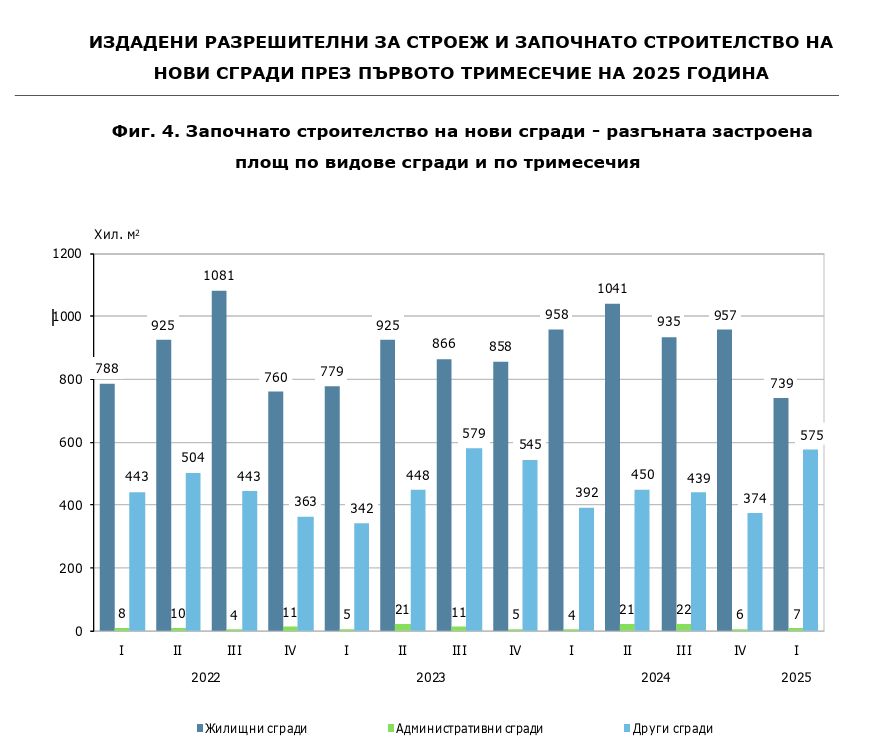
Започнатото строителство според застроената площ е най-малкото от 2021 година насам. През първото тримесечие на 2025 година са започнати жилищни сгради с площ от 739 хил. кв. метра, от които в Пловдив – 289 жилищни, а в София – 158. Това е почти два пъти по-малко.
Интересно – защо в град, който е три пъти по-малък от столицата, се започват толкова много нови жилищни сгради?
Да не би огромното количество красиви, тъмни и празни апартаменти в София най-накрая да са накарали „инвеститорите“ да се замислят?
Може би най-накрая балонът в столицата започва да изпуска въздух. Квартали с претенция за лукс стоят безлюдни, осеяни с обяви „Продава се“, докато светлините вечер напомнят на декор от филм – фасади има, но хора няма. Купувачи липсват, а цените все още се държат изкуствено високи.
В същото време Пловдив привлича повече семейства, студенти и млади хора, които търсят по-достъпно и нормално място за живот. Градът се развива балансирано, със стабилно търсене на реално обитаеми имоти. Това очевидно не е останало незабелязано от строителните предприемачи, които вече търсят по-сигурна среда за реализация на своите проекти.
София отдавна не отговаря на критериите за устойчив растеж. Претоварена инфраструктура, безконтролно презастрояване и социална сегрегация са част от причините хората да гледат към други градове. А когато дори инвеститорите спрат да копаят основи, това означава, че усещат края на илюзията.
Какво следва? Възможно е да започне по-ясно разграничаване между апартаменти за живеене и апартаменти за „инвестиране“, които стоят заключени. Все повече хора започват да се питат – за кого се строи всъщност?
Сигналите са налице. Данните показват спад. А оттук нататък въпросът е дали този спад ще се превърне в корекция на пазара или ще продължим да пълним градовете с бетонни спекулации, които никой не иска да обитава.
И както често се случва – отговорите не са в официалните доклади, а в празните прозорци на иначе „луксозните“ сгради.
Какво още показват тенденциите?
Спадът в започнатото строителство не е изолиран случай, а част от по-широк процес. Ето няколко важни момента:
- Цените на имотите в София се задържат високи, но обемът на реалните сделки спада. Това означава, че има разминаване между търсене и предлагане.
- Голям процент от новото строителство стои непродадено – особено в периферните квартали с лоша инфраструктура.
- Част от „инвеститорите“ пренасочват вниманието си към други градове, където покупките се правят за живеене, а не за спекулация – Пловдив, Бургас, Велико Търново, Стара Загора.
Полезни съвети за купувачи:
- Разглеждайте внимателно местоположението – близост до училища, транспорт, здравеопазване и зелени площи е по-ценна от фасаден „лукс“.
- Проверявайте реалното състояние на сградата и строителя – търсете вече завършени проекти и отзиви от собственици.
- Не се подвеждайте по нереалистични обещания – „светъл апартамент с гледка“ понякога означава северно изложение към паркинг.
- Преговаряйте – при сегашната стагнация строителите са склонни да намалят цената или да добавят бонуси като паркомясто или обзавеждане.
- Проверете статуса на сградата в кадастъра и строителното разрешение – избягвайте обекти със „смесено предназначение“, ако търсите жилище.
🤔 И още нещо…
Ако не ви притиска времето, по-добре изчакайте. Рискът от спад на цените в столицата се увеличава, а конкуренцията в други градове ще принуди пазара да се коригира. Купуването на жилище е най-голямата инвестиция в живота на мнозина – заслужава си тя да бъде обмислена, а не прибързана.
Like this:
Like Loading…
Нашия източник е Българо-Китайска Търговско-промишлена палaта
